Resourcing Talent and Performance Management: A Comprehensive Report
VerifiedAdded on 2021/10/14
|22
|4838
|49
Report
AI Summary
This report provides a comprehensive analysis of resourcing talent and performance management, crucial elements for organizational growth and success in a competitive global environment. It explores the impact of globalization and information and communication technology (ICT) on business environments, emphasizing the need for strategic human resource management. The report delves into key aspects such as talent management strategies, including recruitment, succession planning, and employee retention, highlighting the importance of attracting and retaining top talent. It examines the significance of effective performance management systems, and the features of national and international employment markets. The report references the CIPD 2017 survey, which indicates a growing emphasis on both recruiting highly skilled employees and developing in-house talent through skill enhancement programs. Overall, the report offers insights into the evolving landscape of resourcing and talent management, providing valuable strategies for organizations seeking to enhance their workforce and achieve their strategic objectives.
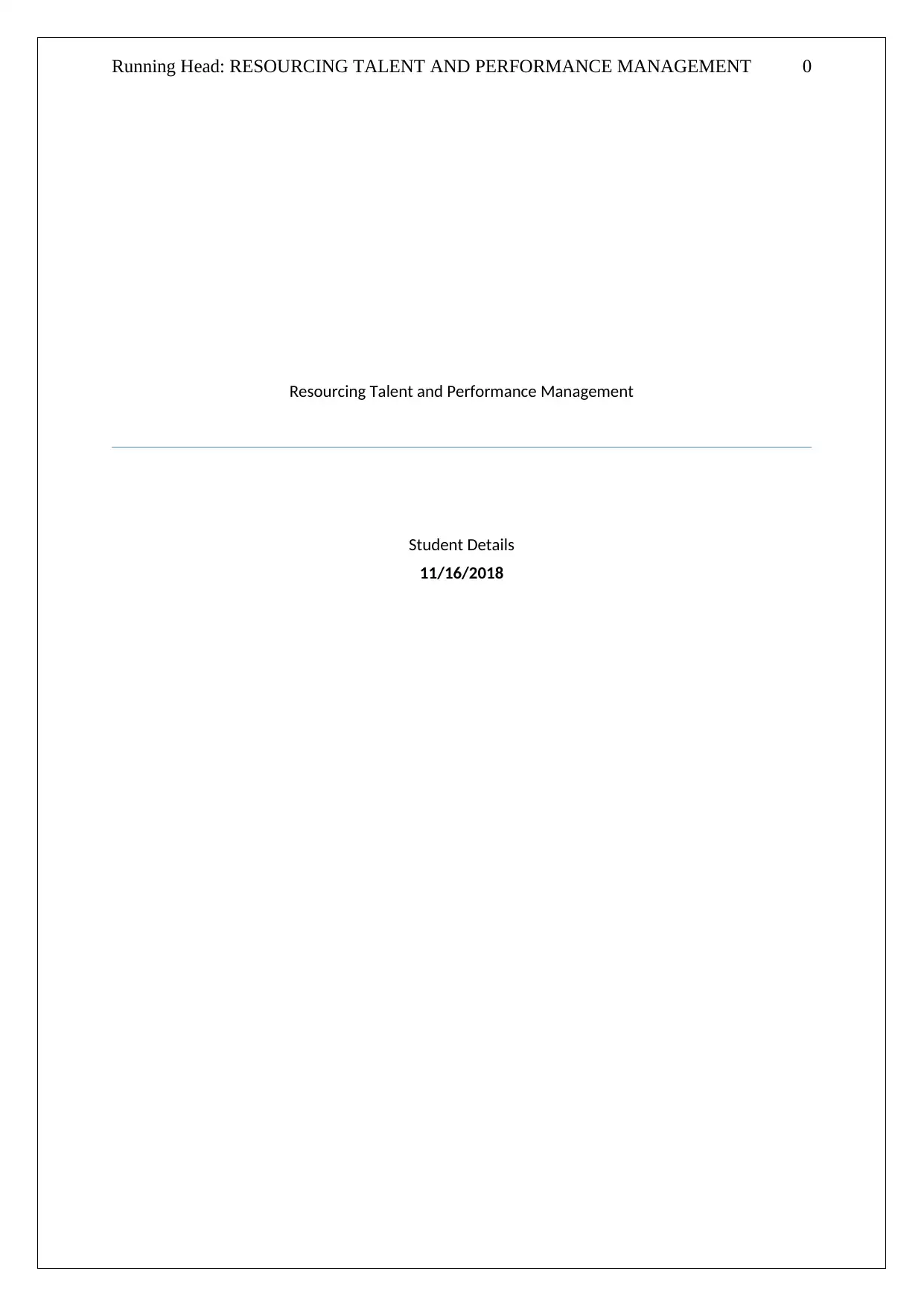
Running Head: RESOURCING TALENT AND PERFORMANCE MANAGEMENT 0
Resourcing Talent and Performance Management
Student Details
11/16/2018
Resourcing Talent and Performance Management
Student Details
11/16/2018
Paraphrase This Document
Need a fresh take? Get an instant paraphrase of this document with our AI Paraphraser
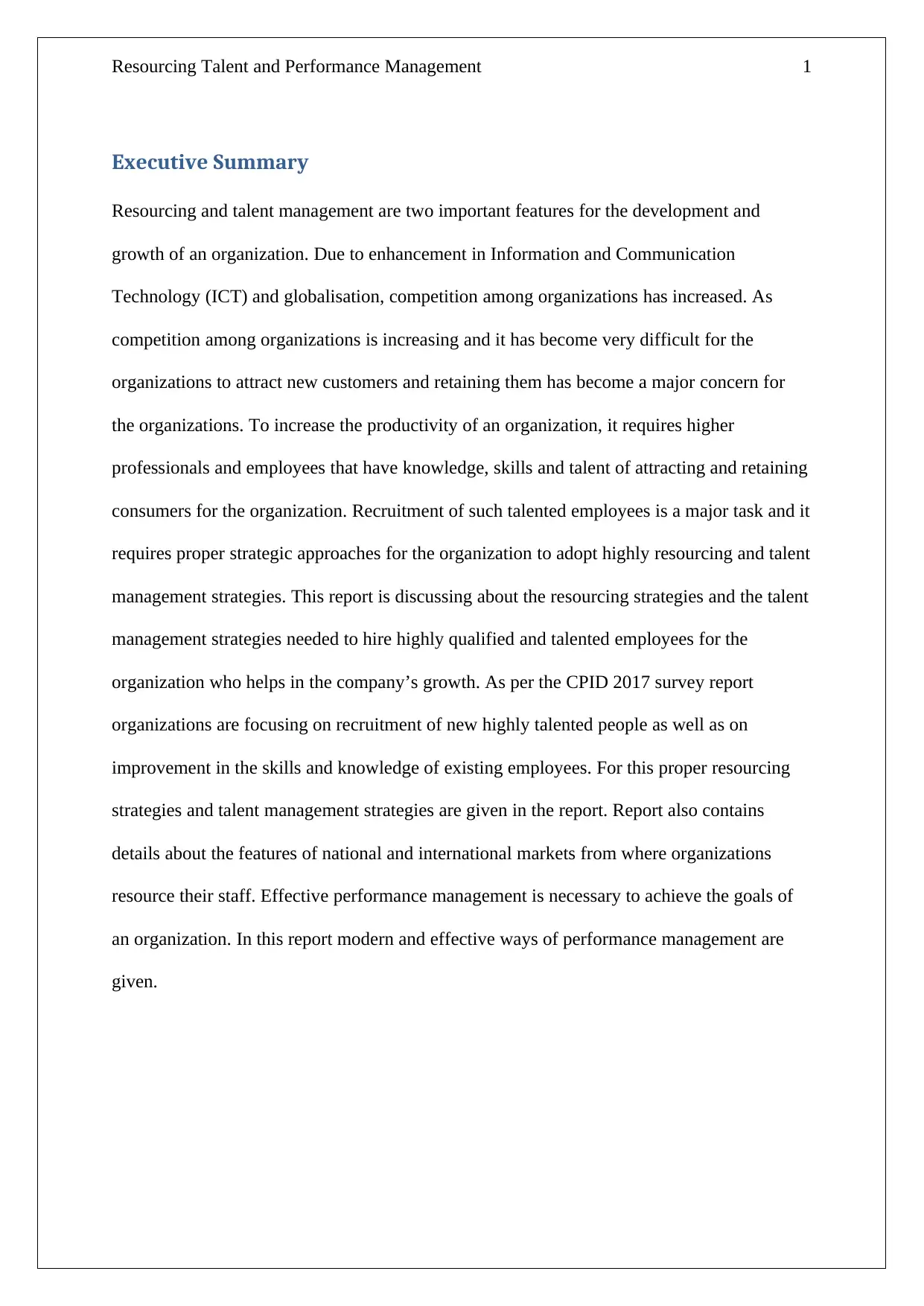
Resourcing Talent and Performance Management 1
Executive Summary
Resourcing and talent management are two important features for the development and
growth of an organization. Due to enhancement in Information and Communication
Technology (ICT) and globalisation, competition among organizations has increased. As
competition among organizations is increasing and it has become very difficult for the
organizations to attract new customers and retaining them has become a major concern for
the organizations. To increase the productivity of an organization, it requires higher
professionals and employees that have knowledge, skills and talent of attracting and retaining
consumers for the organization. Recruitment of such talented employees is a major task and it
requires proper strategic approaches for the organization to adopt highly resourcing and talent
management strategies. This report is discussing about the resourcing strategies and the talent
management strategies needed to hire highly qualified and talented employees for the
organization who helps in the company’s growth. As per the CPID 2017 survey report
organizations are focusing on recruitment of new highly talented people as well as on
improvement in the skills and knowledge of existing employees. For this proper resourcing
strategies and talent management strategies are given in the report. Report also contains
details about the features of national and international markets from where organizations
resource their staff. Effective performance management is necessary to achieve the goals of
an organization. In this report modern and effective ways of performance management are
given.
Executive Summary
Resourcing and talent management are two important features for the development and
growth of an organization. Due to enhancement in Information and Communication
Technology (ICT) and globalisation, competition among organizations has increased. As
competition among organizations is increasing and it has become very difficult for the
organizations to attract new customers and retaining them has become a major concern for
the organizations. To increase the productivity of an organization, it requires higher
professionals and employees that have knowledge, skills and talent of attracting and retaining
consumers for the organization. Recruitment of such talented employees is a major task and it
requires proper strategic approaches for the organization to adopt highly resourcing and talent
management strategies. This report is discussing about the resourcing strategies and the talent
management strategies needed to hire highly qualified and talented employees for the
organization who helps in the company’s growth. As per the CPID 2017 survey report
organizations are focusing on recruitment of new highly talented people as well as on
improvement in the skills and knowledge of existing employees. For this proper resourcing
strategies and talent management strategies are given in the report. Report also contains
details about the features of national and international markets from where organizations
resource their staff. Effective performance management is necessary to achieve the goals of
an organization. In this report modern and effective ways of performance management are
given.
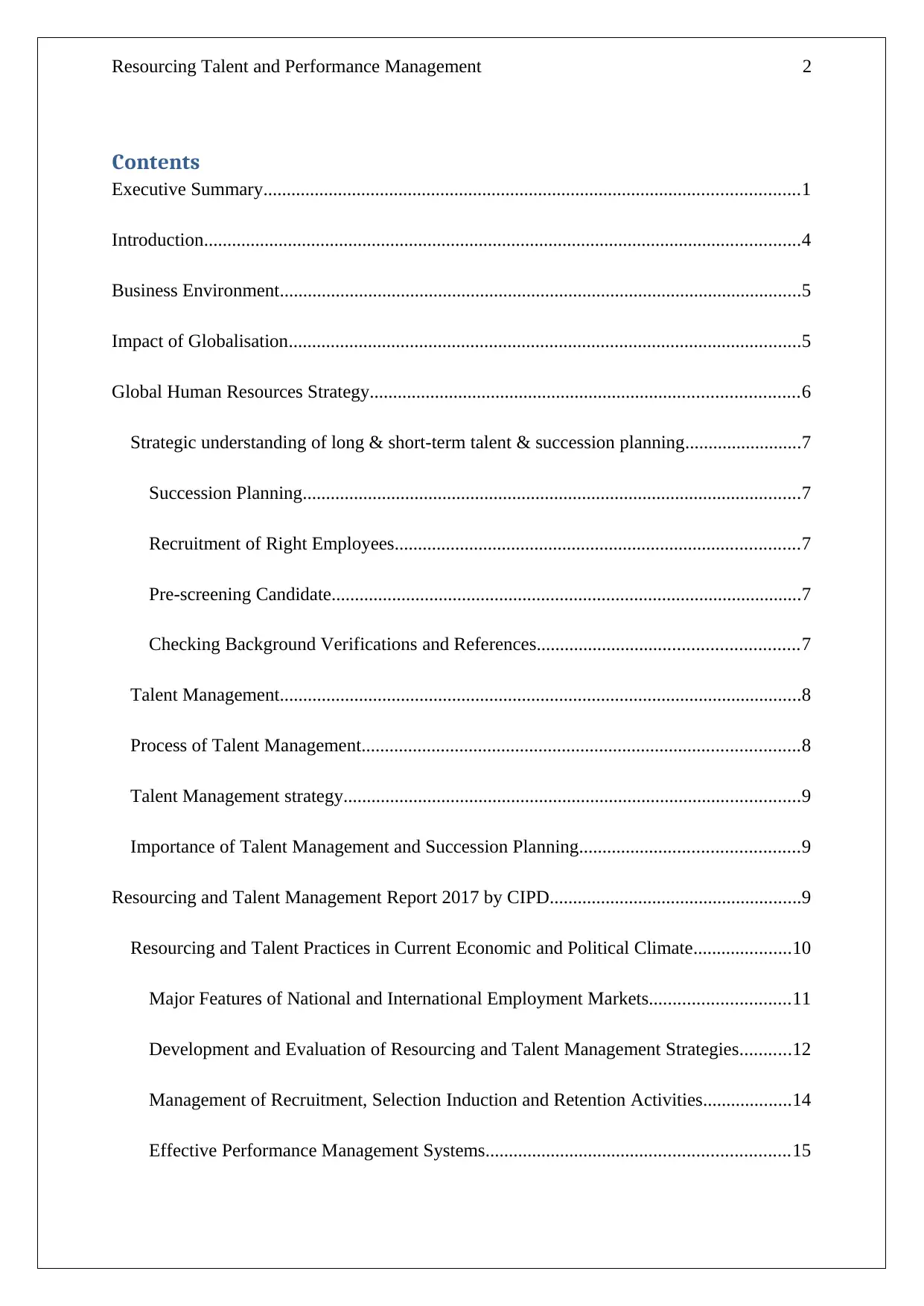
Resourcing Talent and Performance Management 2
Contents
Executive Summary...................................................................................................................1
Introduction................................................................................................................................4
Business Environment................................................................................................................5
Impact of Globalisation..............................................................................................................5
Global Human Resources Strategy............................................................................................6
Strategic understanding of long & short-term talent & succession planning.........................7
Succession Planning...........................................................................................................7
Recruitment of Right Employees.......................................................................................7
Pre-screening Candidate.....................................................................................................7
Checking Background Verifications and References........................................................7
Talent Management................................................................................................................8
Process of Talent Management..............................................................................................8
Talent Management strategy..................................................................................................9
Importance of Talent Management and Succession Planning...............................................9
Resourcing and Talent Management Report 2017 by CIPD......................................................9
Resourcing and Talent Practices in Current Economic and Political Climate.....................10
Major Features of National and International Employment Markets..............................11
Development and Evaluation of Resourcing and Talent Management Strategies...........12
Management of Recruitment, Selection Induction and Retention Activities...................14
Effective Performance Management Systems.................................................................15
Contents
Executive Summary...................................................................................................................1
Introduction................................................................................................................................4
Business Environment................................................................................................................5
Impact of Globalisation..............................................................................................................5
Global Human Resources Strategy............................................................................................6
Strategic understanding of long & short-term talent & succession planning.........................7
Succession Planning...........................................................................................................7
Recruitment of Right Employees.......................................................................................7
Pre-screening Candidate.....................................................................................................7
Checking Background Verifications and References........................................................7
Talent Management................................................................................................................8
Process of Talent Management..............................................................................................8
Talent Management strategy..................................................................................................9
Importance of Talent Management and Succession Planning...............................................9
Resourcing and Talent Management Report 2017 by CIPD......................................................9
Resourcing and Talent Practices in Current Economic and Political Climate.....................10
Major Features of National and International Employment Markets..............................11
Development and Evaluation of Resourcing and Talent Management Strategies...........12
Management of Recruitment, Selection Induction and Retention Activities...................14
Effective Performance Management Systems.................................................................15
⊘ This is a preview!⊘
Do you want full access?
Subscribe today to unlock all pages.

Trusted by 1+ million students worldwide
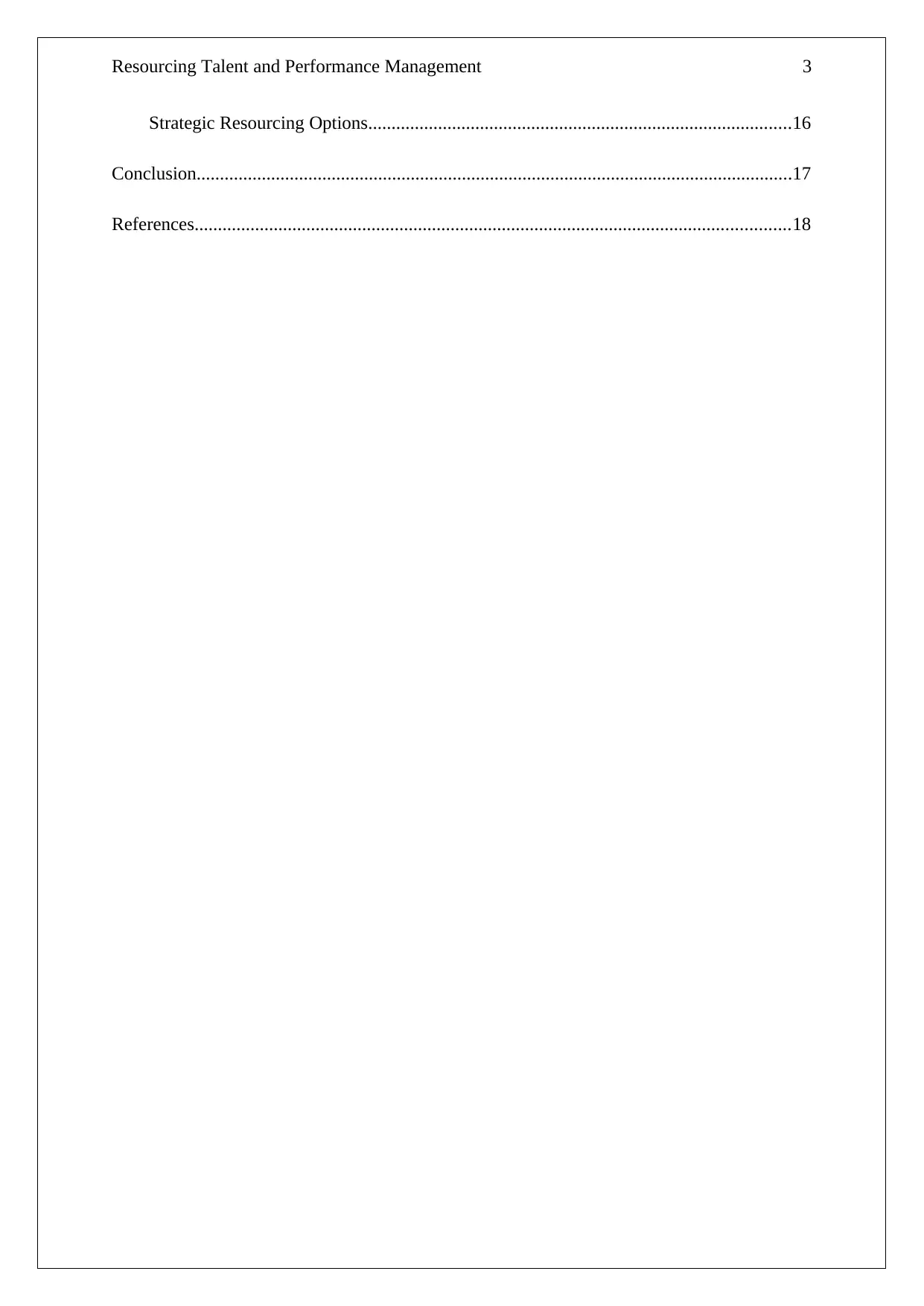
Resourcing Talent and Performance Management 3
Strategic Resourcing Options...........................................................................................16
Conclusion................................................................................................................................17
References................................................................................................................................18
Strategic Resourcing Options...........................................................................................16
Conclusion................................................................................................................................17
References................................................................................................................................18
Paraphrase This Document
Need a fresh take? Get an instant paraphrase of this document with our AI Paraphraser
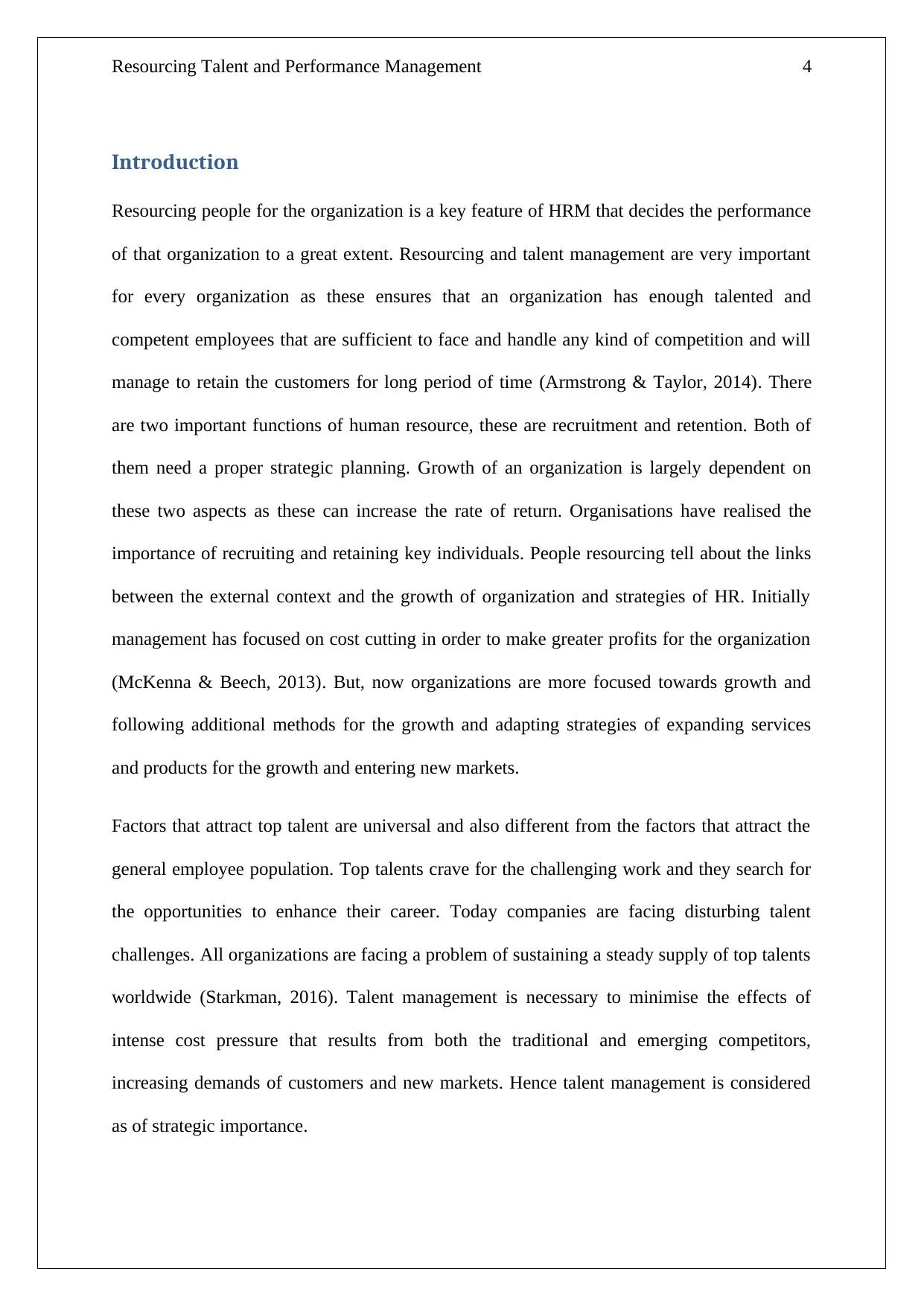
Resourcing Talent and Performance Management 4
Introduction
Resourcing people for the organization is a key feature of HRM that decides the performance
of that organization to a great extent. Resourcing and talent management are very important
for every organization as these ensures that an organization has enough talented and
competent employees that are sufficient to face and handle any kind of competition and will
manage to retain the customers for long period of time (Armstrong & Taylor, 2014). There
are two important functions of human resource, these are recruitment and retention. Both of
them need a proper strategic planning. Growth of an organization is largely dependent on
these two aspects as these can increase the rate of return. Organisations have realised the
importance of recruiting and retaining key individuals. People resourcing tell about the links
between the external context and the growth of organization and strategies of HR. Initially
management has focused on cost cutting in order to make greater profits for the organization
(McKenna & Beech, 2013). But, now organizations are more focused towards growth and
following additional methods for the growth and adapting strategies of expanding services
and products for the growth and entering new markets.
Factors that attract top talent are universal and also different from the factors that attract the
general employee population. Top talents crave for the challenging work and they search for
the opportunities to enhance their career. Today companies are facing disturbing talent
challenges. All organizations are facing a problem of sustaining a steady supply of top talents
worldwide (Starkman, 2016). Talent management is necessary to minimise the effects of
intense cost pressure that results from both the traditional and emerging competitors,
increasing demands of customers and new markets. Hence talent management is considered
as of strategic importance.
Introduction
Resourcing people for the organization is a key feature of HRM that decides the performance
of that organization to a great extent. Resourcing and talent management are very important
for every organization as these ensures that an organization has enough talented and
competent employees that are sufficient to face and handle any kind of competition and will
manage to retain the customers for long period of time (Armstrong & Taylor, 2014). There
are two important functions of human resource, these are recruitment and retention. Both of
them need a proper strategic planning. Growth of an organization is largely dependent on
these two aspects as these can increase the rate of return. Organisations have realised the
importance of recruiting and retaining key individuals. People resourcing tell about the links
between the external context and the growth of organization and strategies of HR. Initially
management has focused on cost cutting in order to make greater profits for the organization
(McKenna & Beech, 2013). But, now organizations are more focused towards growth and
following additional methods for the growth and adapting strategies of expanding services
and products for the growth and entering new markets.
Factors that attract top talent are universal and also different from the factors that attract the
general employee population. Top talents crave for the challenging work and they search for
the opportunities to enhance their career. Today companies are facing disturbing talent
challenges. All organizations are facing a problem of sustaining a steady supply of top talents
worldwide (Starkman, 2016). Talent management is necessary to minimise the effects of
intense cost pressure that results from both the traditional and emerging competitors,
increasing demands of customers and new markets. Hence talent management is considered
as of strategic importance.
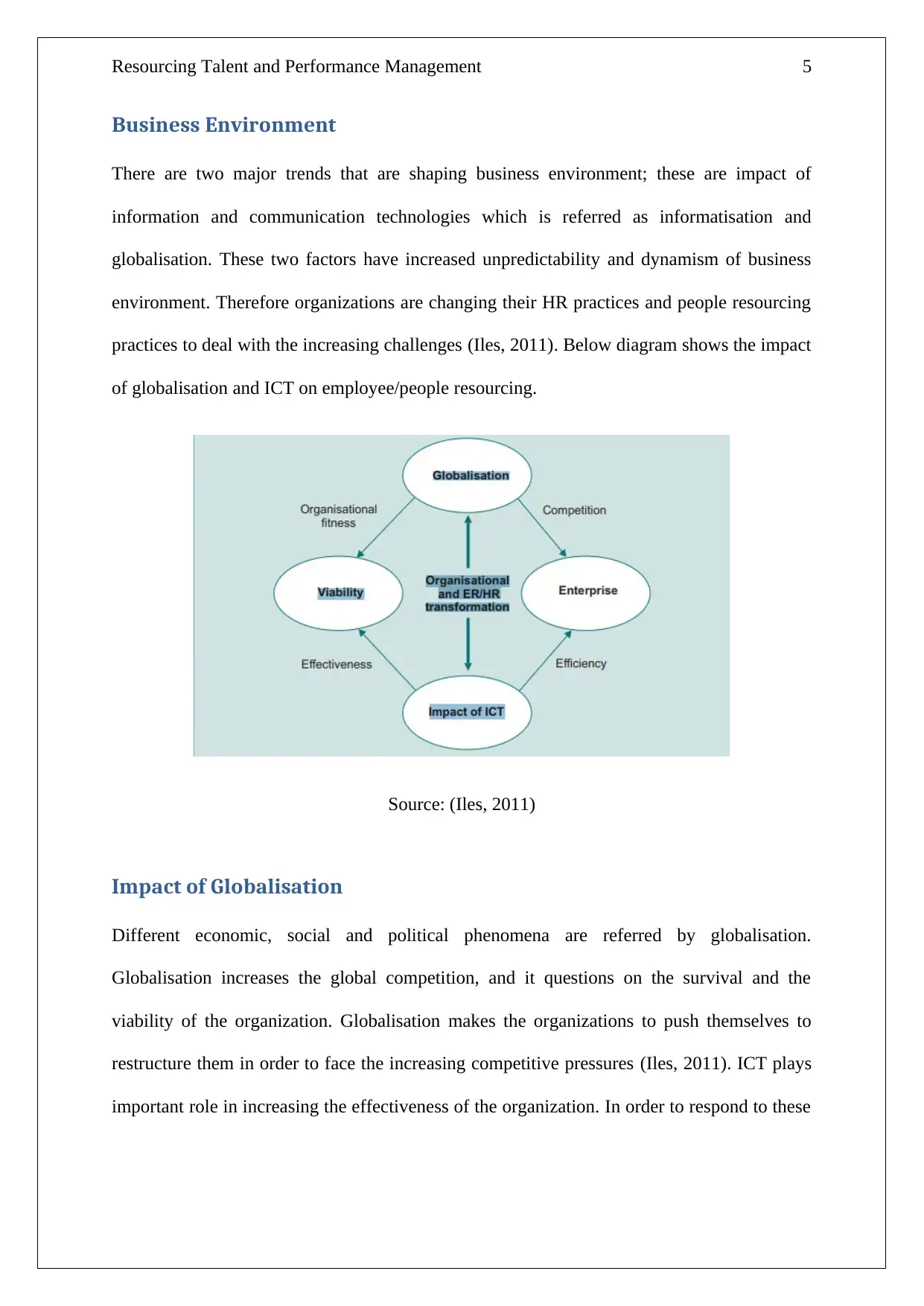
Resourcing Talent and Performance Management 5
Business Environment
There are two major trends that are shaping business environment; these are impact of
information and communication technologies which is referred as informatisation and
globalisation. These two factors have increased unpredictability and dynamism of business
environment. Therefore organizations are changing their HR practices and people resourcing
practices to deal with the increasing challenges (Iles, 2011). Below diagram shows the impact
of globalisation and ICT on employee/people resourcing.
Source: (Iles, 2011)
Impact of Globalisation
Different economic, social and political phenomena are referred by globalisation.
Globalisation increases the global competition, and it questions on the survival and the
viability of the organization. Globalisation makes the organizations to push themselves to
restructure them in order to face the increasing competitive pressures (Iles, 2011). ICT plays
important role in increasing the effectiveness of the organization. In order to respond to these
Business Environment
There are two major trends that are shaping business environment; these are impact of
information and communication technologies which is referred as informatisation and
globalisation. These two factors have increased unpredictability and dynamism of business
environment. Therefore organizations are changing their HR practices and people resourcing
practices to deal with the increasing challenges (Iles, 2011). Below diagram shows the impact
of globalisation and ICT on employee/people resourcing.
Source: (Iles, 2011)
Impact of Globalisation
Different economic, social and political phenomena are referred by globalisation.
Globalisation increases the global competition, and it questions on the survival and the
viability of the organization. Globalisation makes the organizations to push themselves to
restructure them in order to face the increasing competitive pressures (Iles, 2011). ICT plays
important role in increasing the effectiveness of the organization. In order to respond to these
⊘ This is a preview!⊘
Do you want full access?
Subscribe today to unlock all pages.

Trusted by 1+ million students worldwide
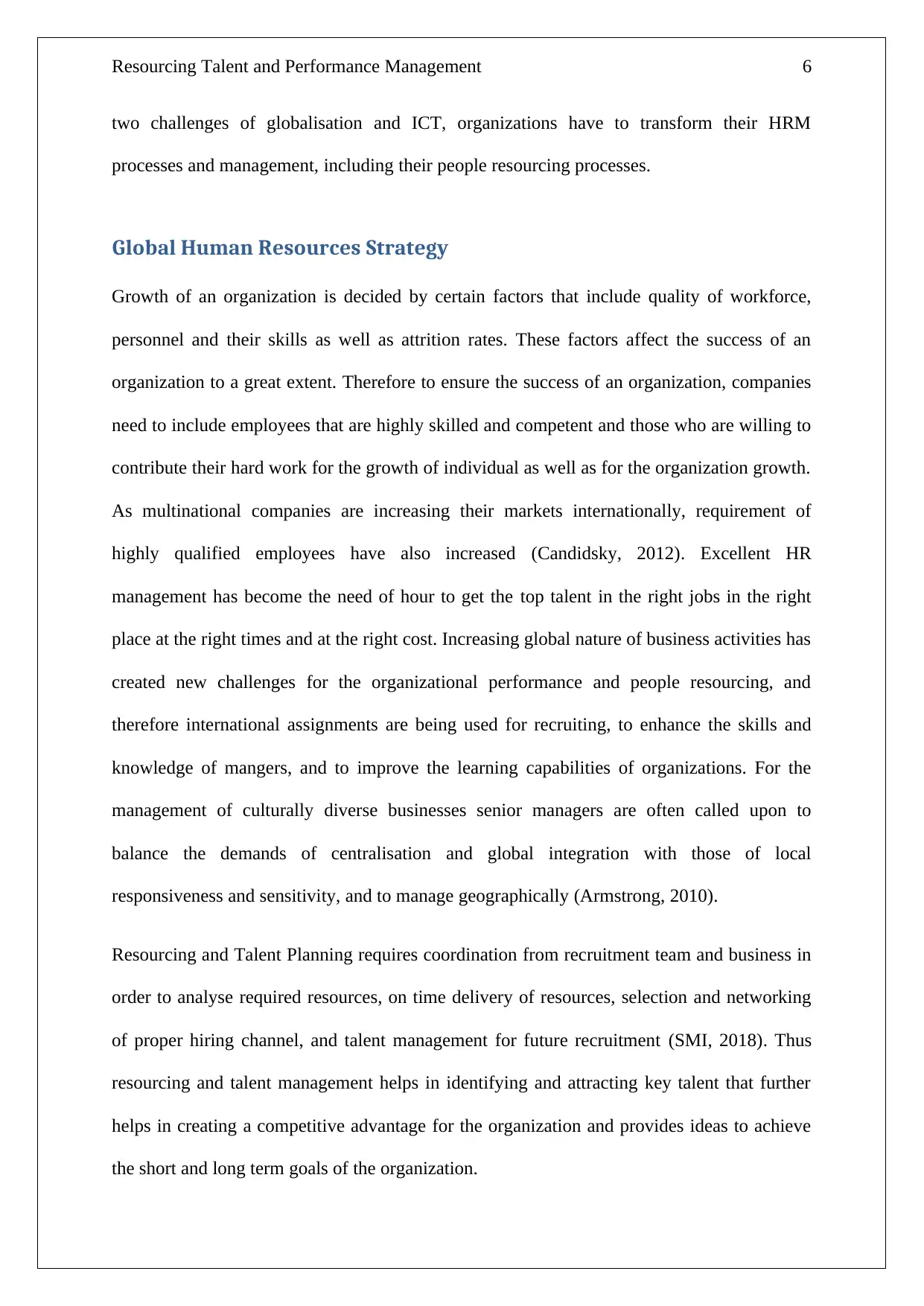
Resourcing Talent and Performance Management 6
two challenges of globalisation and ICT, organizations have to transform their HRM
processes and management, including their people resourcing processes.
Global Human Resources Strategy
Growth of an organization is decided by certain factors that include quality of workforce,
personnel and their skills as well as attrition rates. These factors affect the success of an
organization to a great extent. Therefore to ensure the success of an organization, companies
need to include employees that are highly skilled and competent and those who are willing to
contribute their hard work for the growth of individual as well as for the organization growth.
As multinational companies are increasing their markets internationally, requirement of
highly qualified employees have also increased (Candidsky, 2012). Excellent HR
management has become the need of hour to get the top talent in the right jobs in the right
place at the right times and at the right cost. Increasing global nature of business activities has
created new challenges for the organizational performance and people resourcing, and
therefore international assignments are being used for recruiting, to enhance the skills and
knowledge of mangers, and to improve the learning capabilities of organizations. For the
management of culturally diverse businesses senior managers are often called upon to
balance the demands of centralisation and global integration with those of local
responsiveness and sensitivity, and to manage geographically (Armstrong, 2010).
Resourcing and Talent Planning requires coordination from recruitment team and business in
order to analyse required resources, on time delivery of resources, selection and networking
of proper hiring channel, and talent management for future recruitment (SMI, 2018). Thus
resourcing and talent management helps in identifying and attracting key talent that further
helps in creating a competitive advantage for the organization and provides ideas to achieve
the short and long term goals of the organization.
two challenges of globalisation and ICT, organizations have to transform their HRM
processes and management, including their people resourcing processes.
Global Human Resources Strategy
Growth of an organization is decided by certain factors that include quality of workforce,
personnel and their skills as well as attrition rates. These factors affect the success of an
organization to a great extent. Therefore to ensure the success of an organization, companies
need to include employees that are highly skilled and competent and those who are willing to
contribute their hard work for the growth of individual as well as for the organization growth.
As multinational companies are increasing their markets internationally, requirement of
highly qualified employees have also increased (Candidsky, 2012). Excellent HR
management has become the need of hour to get the top talent in the right jobs in the right
place at the right times and at the right cost. Increasing global nature of business activities has
created new challenges for the organizational performance and people resourcing, and
therefore international assignments are being used for recruiting, to enhance the skills and
knowledge of mangers, and to improve the learning capabilities of organizations. For the
management of culturally diverse businesses senior managers are often called upon to
balance the demands of centralisation and global integration with those of local
responsiveness and sensitivity, and to manage geographically (Armstrong, 2010).
Resourcing and Talent Planning requires coordination from recruitment team and business in
order to analyse required resources, on time delivery of resources, selection and networking
of proper hiring channel, and talent management for future recruitment (SMI, 2018). Thus
resourcing and talent management helps in identifying and attracting key talent that further
helps in creating a competitive advantage for the organization and provides ideas to achieve
the short and long term goals of the organization.
Paraphrase This Document
Need a fresh take? Get an instant paraphrase of this document with our AI Paraphraser
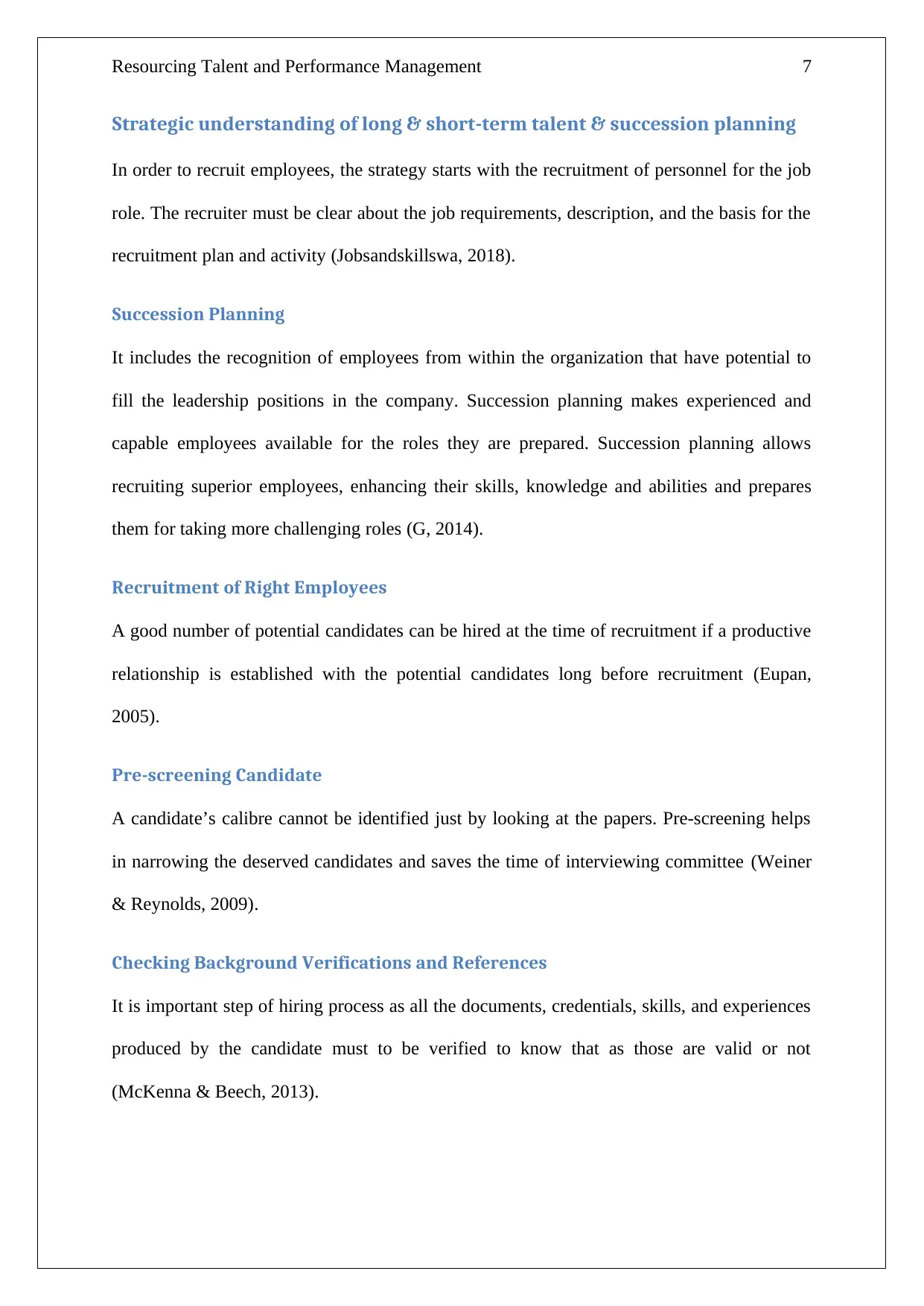
Resourcing Talent and Performance Management 7
Strategic understanding of long & short-term talent & succession planning
In order to recruit employees, the strategy starts with the recruitment of personnel for the job
role. The recruiter must be clear about the job requirements, description, and the basis for the
recruitment plan and activity (Jobsandskillswa, 2018).
Succession Planning
It includes the recognition of employees from within the organization that have potential to
fill the leadership positions in the company. Succession planning makes experienced and
capable employees available for the roles they are prepared. Succession planning allows
recruiting superior employees, enhancing their skills, knowledge and abilities and prepares
them for taking more challenging roles (G, 2014).
Recruitment of Right Employees
A good number of potential candidates can be hired at the time of recruitment if a productive
relationship is established with the potential candidates long before recruitment (Eupan,
2005).
Pre-screening Candidate
A candidate’s calibre cannot be identified just by looking at the papers. Pre-screening helps
in narrowing the deserved candidates and saves the time of interviewing committee (Weiner
& Reynolds, 2009).
Checking Background Verifications and References
It is important step of hiring process as all the documents, credentials, skills, and experiences
produced by the candidate must to be verified to know that as those are valid or not
(McKenna & Beech, 2013).
Strategic understanding of long & short-term talent & succession planning
In order to recruit employees, the strategy starts with the recruitment of personnel for the job
role. The recruiter must be clear about the job requirements, description, and the basis for the
recruitment plan and activity (Jobsandskillswa, 2018).
Succession Planning
It includes the recognition of employees from within the organization that have potential to
fill the leadership positions in the company. Succession planning makes experienced and
capable employees available for the roles they are prepared. Succession planning allows
recruiting superior employees, enhancing their skills, knowledge and abilities and prepares
them for taking more challenging roles (G, 2014).
Recruitment of Right Employees
A good number of potential candidates can be hired at the time of recruitment if a productive
relationship is established with the potential candidates long before recruitment (Eupan,
2005).
Pre-screening Candidate
A candidate’s calibre cannot be identified just by looking at the papers. Pre-screening helps
in narrowing the deserved candidates and saves the time of interviewing committee (Weiner
& Reynolds, 2009).
Checking Background Verifications and References
It is important step of hiring process as all the documents, credentials, skills, and experiences
produced by the candidate must to be verified to know that as those are valid or not
(McKenna & Beech, 2013).
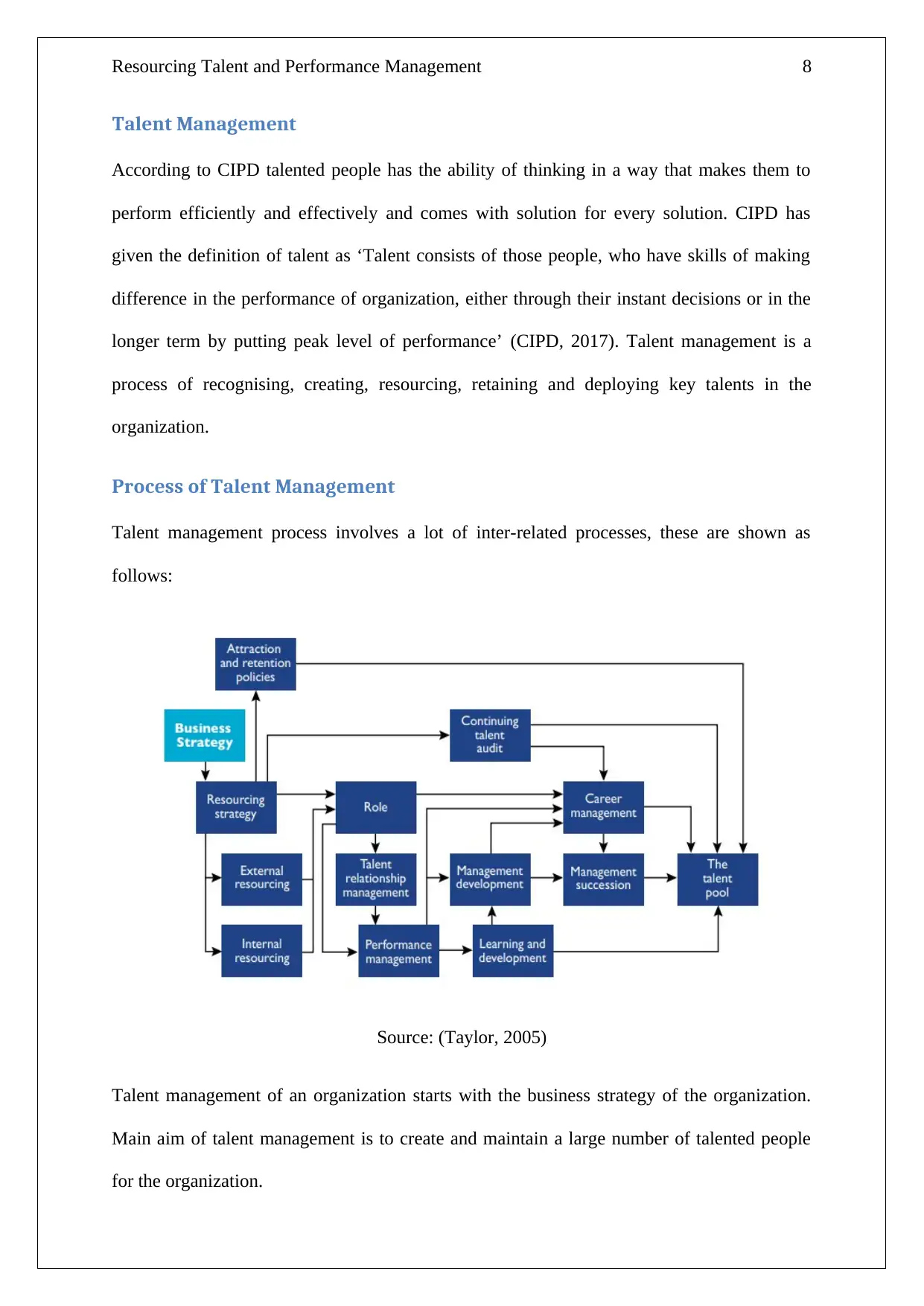
Resourcing Talent and Performance Management 8
Talent Management
According to CIPD talented people has the ability of thinking in a way that makes them to
perform efficiently and effectively and comes with solution for every solution. CIPD has
given the definition of talent as ‘Talent consists of those people, who have skills of making
difference in the performance of organization, either through their instant decisions or in the
longer term by putting peak level of performance’ (CIPD, 2017). Talent management is a
process of recognising, creating, resourcing, retaining and deploying key talents in the
organization.
Process of Talent Management
Talent management process involves a lot of inter-related processes, these are shown as
follows:
Source: (Taylor, 2005)
Talent management of an organization starts with the business strategy of the organization.
Main aim of talent management is to create and maintain a large number of talented people
for the organization.
Talent Management
According to CIPD talented people has the ability of thinking in a way that makes them to
perform efficiently and effectively and comes with solution for every solution. CIPD has
given the definition of talent as ‘Talent consists of those people, who have skills of making
difference in the performance of organization, either through their instant decisions or in the
longer term by putting peak level of performance’ (CIPD, 2017). Talent management is a
process of recognising, creating, resourcing, retaining and deploying key talents in the
organization.
Process of Talent Management
Talent management process involves a lot of inter-related processes, these are shown as
follows:
Source: (Taylor, 2005)
Talent management of an organization starts with the business strategy of the organization.
Main aim of talent management is to create and maintain a large number of talented people
for the organization.
⊘ This is a preview!⊘
Do you want full access?
Subscribe today to unlock all pages.

Trusted by 1+ million students worldwide
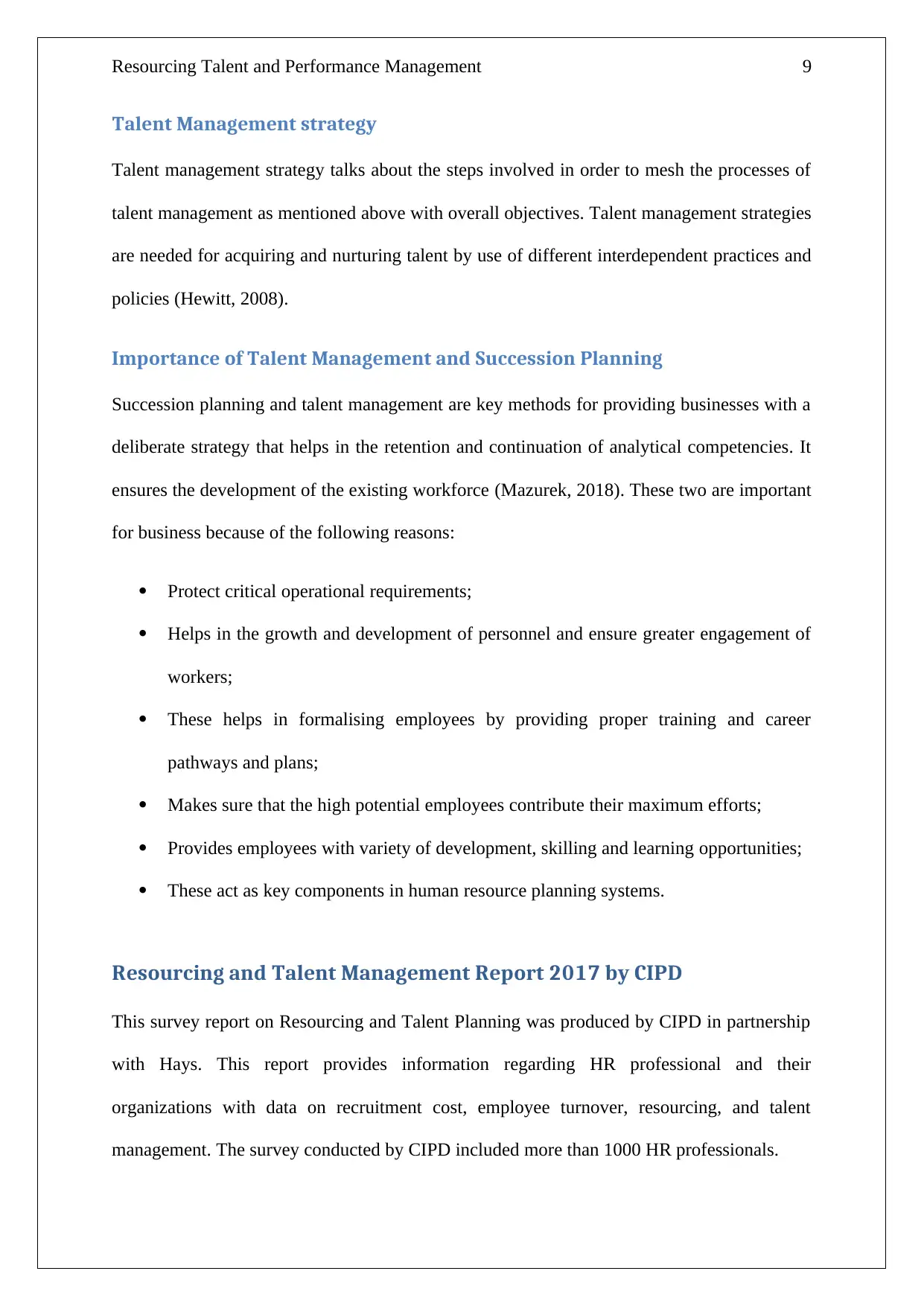
Resourcing Talent and Performance Management 9
Talent Management strategy
Talent management strategy talks about the steps involved in order to mesh the processes of
talent management as mentioned above with overall objectives. Talent management strategies
are needed for acquiring and nurturing talent by use of different interdependent practices and
policies (Hewitt, 2008).
Importance of Talent Management and Succession Planning
Succession planning and talent management are key methods for providing businesses with a
deliberate strategy that helps in the retention and continuation of analytical competencies. It
ensures the development of the existing workforce (Mazurek, 2018). These two are important
for business because of the following reasons:
Protect critical operational requirements;
Helps in the growth and development of personnel and ensure greater engagement of
workers;
These helps in formalising employees by providing proper training and career
pathways and plans;
Makes sure that the high potential employees contribute their maximum efforts;
Provides employees with variety of development, skilling and learning opportunities;
These act as key components in human resource planning systems.
Resourcing and Talent Management Report 2017 by CIPD
This survey report on Resourcing and Talent Planning was produced by CIPD in partnership
with Hays. This report provides information regarding HR professional and their
organizations with data on recruitment cost, employee turnover, resourcing, and talent
management. The survey conducted by CIPD included more than 1000 HR professionals.
Talent Management strategy
Talent management strategy talks about the steps involved in order to mesh the processes of
talent management as mentioned above with overall objectives. Talent management strategies
are needed for acquiring and nurturing talent by use of different interdependent practices and
policies (Hewitt, 2008).
Importance of Talent Management and Succession Planning
Succession planning and talent management are key methods for providing businesses with a
deliberate strategy that helps in the retention and continuation of analytical competencies. It
ensures the development of the existing workforce (Mazurek, 2018). These two are important
for business because of the following reasons:
Protect critical operational requirements;
Helps in the growth and development of personnel and ensure greater engagement of
workers;
These helps in formalising employees by providing proper training and career
pathways and plans;
Makes sure that the high potential employees contribute their maximum efforts;
Provides employees with variety of development, skilling and learning opportunities;
These act as key components in human resource planning systems.
Resourcing and Talent Management Report 2017 by CIPD
This survey report on Resourcing and Talent Planning was produced by CIPD in partnership
with Hays. This report provides information regarding HR professional and their
organizations with data on recruitment cost, employee turnover, resourcing, and talent
management. The survey conducted by CIPD included more than 1000 HR professionals.
Paraphrase This Document
Need a fresh take? Get an instant paraphrase of this document with our AI Paraphraser
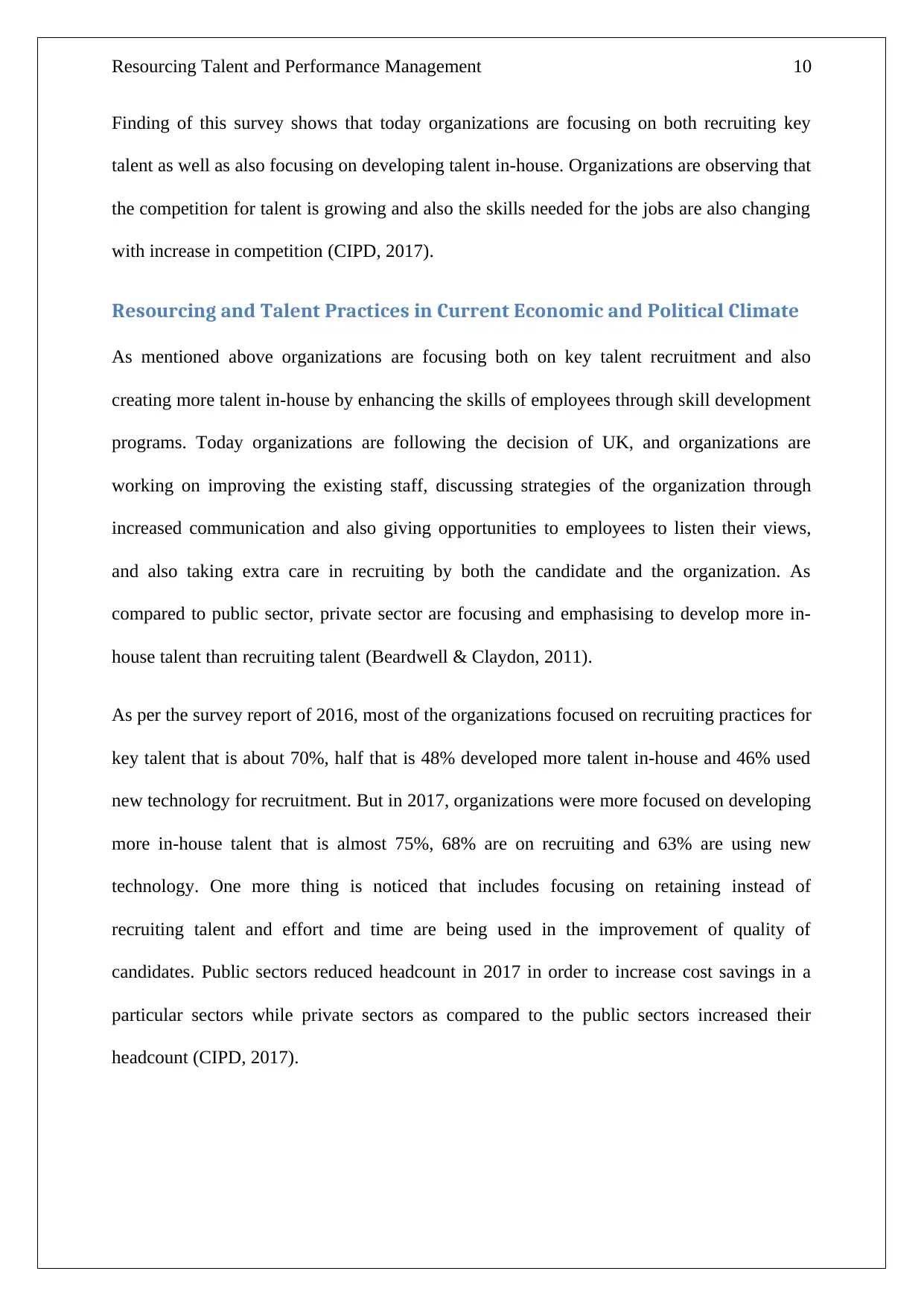
Resourcing Talent and Performance Management 10
Finding of this survey shows that today organizations are focusing on both recruiting key
talent as well as also focusing on developing talent in-house. Organizations are observing that
the competition for talent is growing and also the skills needed for the jobs are also changing
with increase in competition (CIPD, 2017).
Resourcing and Talent Practices in Current Economic and Political Climate
As mentioned above organizations are focusing both on key talent recruitment and also
creating more talent in-house by enhancing the skills of employees through skill development
programs. Today organizations are following the decision of UK, and organizations are
working on improving the existing staff, discussing strategies of the organization through
increased communication and also giving opportunities to employees to listen their views,
and also taking extra care in recruiting by both the candidate and the organization. As
compared to public sector, private sector are focusing and emphasising to develop more in-
house talent than recruiting talent (Beardwell & Claydon, 2011).
As per the survey report of 2016, most of the organizations focused on recruiting practices for
key talent that is about 70%, half that is 48% developed more talent in-house and 46% used
new technology for recruitment. But in 2017, organizations were more focused on developing
more in-house talent that is almost 75%, 68% are on recruiting and 63% are using new
technology. One more thing is noticed that includes focusing on retaining instead of
recruiting talent and effort and time are being used in the improvement of quality of
candidates. Public sectors reduced headcount in 2017 in order to increase cost savings in a
particular sectors while private sectors as compared to the public sectors increased their
headcount (CIPD, 2017).
Finding of this survey shows that today organizations are focusing on both recruiting key
talent as well as also focusing on developing talent in-house. Organizations are observing that
the competition for talent is growing and also the skills needed for the jobs are also changing
with increase in competition (CIPD, 2017).
Resourcing and Talent Practices in Current Economic and Political Climate
As mentioned above organizations are focusing both on key talent recruitment and also
creating more talent in-house by enhancing the skills of employees through skill development
programs. Today organizations are following the decision of UK, and organizations are
working on improving the existing staff, discussing strategies of the organization through
increased communication and also giving opportunities to employees to listen their views,
and also taking extra care in recruiting by both the candidate and the organization. As
compared to public sector, private sector are focusing and emphasising to develop more in-
house talent than recruiting talent (Beardwell & Claydon, 2011).
As per the survey report of 2016, most of the organizations focused on recruiting practices for
key talent that is about 70%, half that is 48% developed more talent in-house and 46% used
new technology for recruitment. But in 2017, organizations were more focused on developing
more in-house talent that is almost 75%, 68% are on recruiting and 63% are using new
technology. One more thing is noticed that includes focusing on retaining instead of
recruiting talent and effort and time are being used in the improvement of quality of
candidates. Public sectors reduced headcount in 2017 in order to increase cost savings in a
particular sectors while private sectors as compared to the public sectors increased their
headcount (CIPD, 2017).
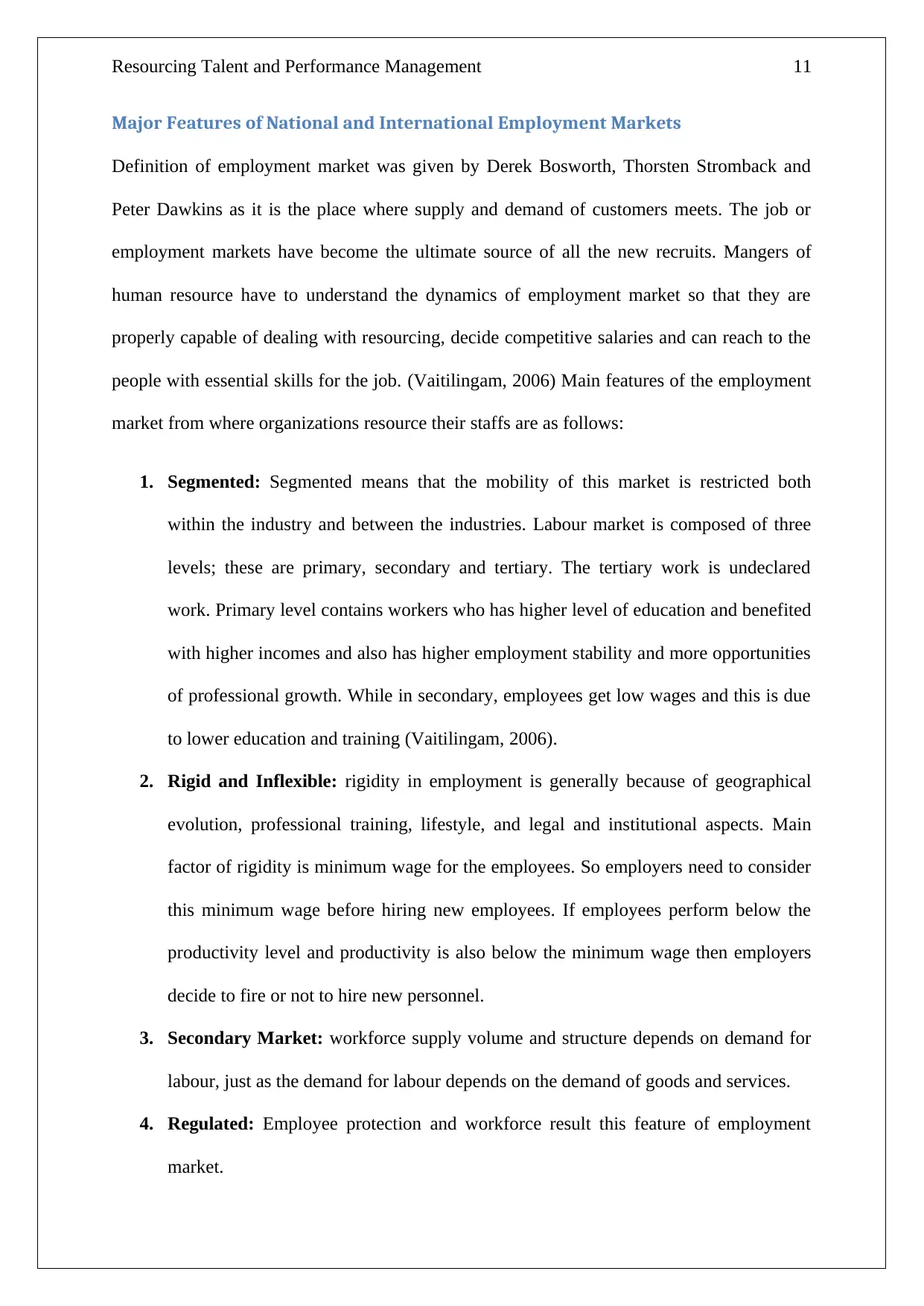
Resourcing Talent and Performance Management 11
Major Features of National and International Employment Markets
Definition of employment market was given by Derek Bosworth, Thorsten Stromback and
Peter Dawkins as it is the place where supply and demand of customers meets. The job or
employment markets have become the ultimate source of all the new recruits. Mangers of
human resource have to understand the dynamics of employment market so that they are
properly capable of dealing with resourcing, decide competitive salaries and can reach to the
people with essential skills for the job. (Vaitilingam, 2006) Main features of the employment
market from where organizations resource their staffs are as follows:
1. Segmented: Segmented means that the mobility of this market is restricted both
within the industry and between the industries. Labour market is composed of three
levels; these are primary, secondary and tertiary. The tertiary work is undeclared
work. Primary level contains workers who has higher level of education and benefited
with higher incomes and also has higher employment stability and more opportunities
of professional growth. While in secondary, employees get low wages and this is due
to lower education and training (Vaitilingam, 2006).
2. Rigid and Inflexible: rigidity in employment is generally because of geographical
evolution, professional training, lifestyle, and legal and institutional aspects. Main
factor of rigidity is minimum wage for the employees. So employers need to consider
this minimum wage before hiring new employees. If employees perform below the
productivity level and productivity is also below the minimum wage then employers
decide to fire or not to hire new personnel.
3. Secondary Market: workforce supply volume and structure depends on demand for
labour, just as the demand for labour depends on the demand of goods and services.
4. Regulated: Employee protection and workforce result this feature of employment
market.
Major Features of National and International Employment Markets
Definition of employment market was given by Derek Bosworth, Thorsten Stromback and
Peter Dawkins as it is the place where supply and demand of customers meets. The job or
employment markets have become the ultimate source of all the new recruits. Mangers of
human resource have to understand the dynamics of employment market so that they are
properly capable of dealing with resourcing, decide competitive salaries and can reach to the
people with essential skills for the job. (Vaitilingam, 2006) Main features of the employment
market from where organizations resource their staffs are as follows:
1. Segmented: Segmented means that the mobility of this market is restricted both
within the industry and between the industries. Labour market is composed of three
levels; these are primary, secondary and tertiary. The tertiary work is undeclared
work. Primary level contains workers who has higher level of education and benefited
with higher incomes and also has higher employment stability and more opportunities
of professional growth. While in secondary, employees get low wages and this is due
to lower education and training (Vaitilingam, 2006).
2. Rigid and Inflexible: rigidity in employment is generally because of geographical
evolution, professional training, lifestyle, and legal and institutional aspects. Main
factor of rigidity is minimum wage for the employees. So employers need to consider
this minimum wage before hiring new employees. If employees perform below the
productivity level and productivity is also below the minimum wage then employers
decide to fire or not to hire new personnel.
3. Secondary Market: workforce supply volume and structure depends on demand for
labour, just as the demand for labour depends on the demand of goods and services.
4. Regulated: Employee protection and workforce result this feature of employment
market.
⊘ This is a preview!⊘
Do you want full access?
Subscribe today to unlock all pages.

Trusted by 1+ million students worldwide
1 out of 22
Related Documents
Your All-in-One AI-Powered Toolkit for Academic Success.
+13062052269
info@desklib.com
Available 24*7 on WhatsApp / Email
![[object Object]](/_next/static/media/star-bottom.7253800d.svg)
Unlock your academic potential
Copyright © 2020–2025 A2Z Services. All Rights Reserved. Developed and managed by ZUCOL.





